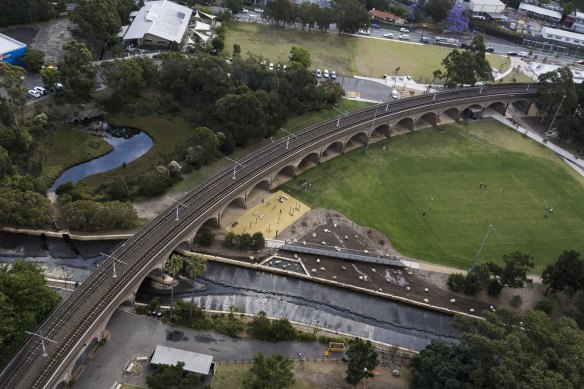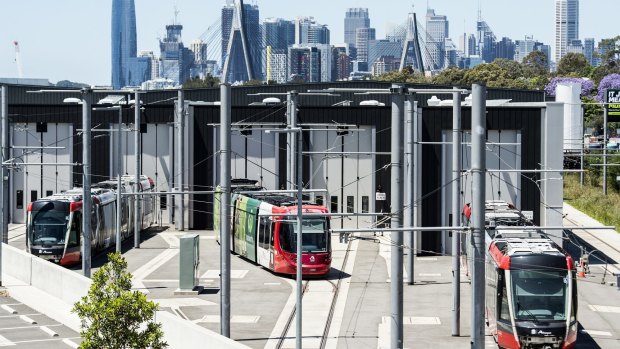- Exclusive
- National
- NSW
- Public transport
This was published 2 years ago
‘High speeds, sharp curves’ contribute to cracked trams: Spanish builder
By Tom Rabe
The Spanish manufacturer of Sydney’s cracked trams warned the NSW government that sharp track bends had contributed to the faults, while new documents show questions were raised in the transport department over the standard of track maintenance.
The documents, tabled to NSW Parliament under an upper house order and seen by the Herald, also show key instructions about welding cracks on the trams were written in Spanish.

A view over the inner west light rail track leading into Jubilee Park.Credit: Brook Mitchell
Internal NSW government emails, as well as correspondence between the state and manufacturer CAF show the company told the government the trams had been travelling at “high speed” through “sharp curves” on the inner west network.
One note, sent to Transport for NSW on November 3, said the company believed this had contributed to cracking found in the entire fleet as well as key components on the trams operating “below minimum tolerance”.
“CAF current understanding is that the main factors influencing the appearance of the cracks in the Sydney fleet have been … No transition curves before or after sharp curves with low radius, and trams running at high speeds through these sharp curves,” the note said, among other points.
An email sent one day later between two Transport for NSW staff asked “was the track actually built to the necessary standard?“.
“Unknown,” the reply said.
“However, CAF were sent Sydney track design data, fully representative of original project.”
The inner west light rail system has been paralysed for up to 18 months after it was first revealed cracks had been found in all 12 trams servicing the network.
The government last week began trialling CBD trams on the inner west tracks, which runs from Dulwich Hill to Central Station, in a bid to return services to the network earlier.
A Transport for NSW spokeswoman on Sunday said early tests of the CBD trams had proven successful, with more to come in coming weeks before any decision is made.
The spokeswoman said the root cause of the cracking was still being investigated, and it was premature to draw any meaningful conclusions.
“Transport for NSW’s highest priority is customer safety. We are working to ensure that the inner west light rail is brought back into service as soon as possible,” the spokeswoman said.
The new emails show some of the instructions relied upon by transport staff in the days after cracks were discovered were written in Spanish.
“There is an instruction about welding L bracket cracks. However, apart from some of the language is in Spanish[sic],” the email said. “I will go back to [employee name] and ask him to update this document in English (where Spanish is used).”
The Transport for NSW spokeswoman said it was not uncommon for instructions to be in different languages, and was a “well-versed part of global engineering”.
“It has not proven to be an impediment in this matter,” she said.
NSW Opposition Leader Chris Minns said the correspondence raised serious concerns as to whether the trams had been operating in accordance with design specifications.
“It is also concerning that we have a situation where Transport for NSW officials don’t have access to light rail maintenance documents they understand,” Mr Minns said.
“It is well past time the secrets ended. It is time the transport minister gives us a road map for the light rail returning to service and who will be left paying the clean-up bill.”

Sydney’s Inner West Light Rail line is closed for up to 18 months for repair work to be carried out on the carriages due to cracks being found. Credit: Steven Siewert
The Herald last week revealed the NSW government had known for close to a month that the trams were cracked.
The NSW government has come under scrutiny for the 2015 decision to procure the trams from a Spanish manufacturer, though Transport Minister Rob Stokes says no Australian firm bid for the work.
Mr Stokes has repeatedly said that NSW taxpayers will not be made to pay for the rectifications, but no agreement has been reached between the government, CAF and the private consortium which runs the network ALTRAC.
The Morning Edition newsletter is our guide to the day’s most important and interesting stories, analysis and insights. Sign up here.